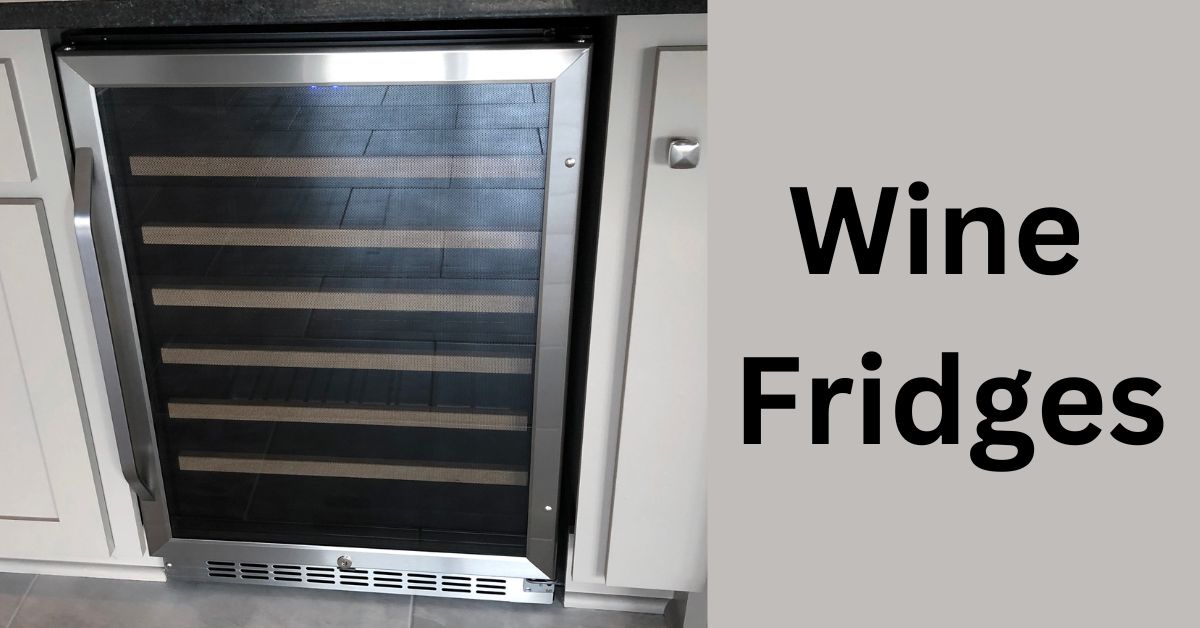Table of Contents
Note: If you came to this post on wine fridges through a random search, please click on this parent page and our home page for more context.
Why a Wine Fridge?
A wine cooler refrigerator makes a great addition to a remodel project. We explain why below and present a number of these units for your information.
Is a Wine Fridge Necessary?
If you are a wine lover or love entertaining, a wine fridge is a great addition. Include it in the arsenal of kitchen appliances you are planning for your kitchen remodel. It will add both pizazz and utility to the finished kitchen remodel project. It will also help with resale.
“Wine Cooler” or “Wine Fridge?”
But first to clarify a point of language and define terms. A wine cooler is actually a low-strength alcoholic beverage made from wine and fruit juice. But, the phrase is also used to describe a wine refrigerator. So, to avoid confusion, we’ll stick with “wine refrigerator” or “wine fridge.”
6 Good Reasons for a Wine Fridge
Why do you need a wine fridge? Why don’t I keep my wine in a regular fridge?
Well, a regular fridge is designed to keep many different types of foodstuff cool. And its temperatures and humidity can vary widely. Besides, a variety of odors are present.
If you are serious about your wine, you will want a wine fridge. Here’s why:
- A wine fridge maintains a constant temperature and humidity, which is what wine likes.
- A dual-zone wine fridge can keep both reds and whites at their respective best temperatures.
- Wine does not like vibration. Wine fridges produce less vibration than regular fridges.
- Wine bottle corks need to be maintained at the right level of constant humidity.
- Even though protected by the cork, wine should be kept away from the odors that are present in a regular fridge.
- UV light is the enemy of wine. Although this is not really an issue with a regular fridge, the special fronts of wine fridges keep UV light away from the wine.
The bottom line is that a wine fridge provides the best environment in which to keep wine.
All your wines will be drinkable longer. It will help some wines continue to age. And some wine will just taste better.
Wine Storage vs Other Storage Needs
If you plan to include a wine fridge in your kitchen remodel, you need to have thought through all your kitchen storage needs. It means that you give at least some priority to wine over other storage requirements. This in turn means that you will probably only install a wine fridge in a fairly large kitchen.
Where Else Would I Put a Wine Fridge?
In our experience, most people put the wine fridge in the kitchen. But we have also put them in wet and dry bars, basements; game rooms; dining rooms; and purpose-built wine cellars.
- Do not put it next to another appliance, especially an oven
- Do not put it in direct sunlight
- Do not put it in a garage
Does a Wine Fridge Add Value?
All remodel projects should have the thought of eventual resale at least in the back of the mind. And a wine fridge is a good and inexpensive value add component and selling feature.
The subtle suggestion is that your home is where the good life is and the buyer will want to be part of that.
Built-in vs Freestanding Wine Fridge?
There are two main types of wine fridges to consider for your remodel project. One is under the counter or built-in and the other is free-standing. It is important to understand the differences because it affects installation and location.
The main difference is how they vent or expel the warm air they generate in the cooling process. You can see the front vent in the image to the right above.
Some wine fridges are made to be either built-in or freestanding. But in both cases, the venting will be to the front
Under-Counter Wine Fridge
The under-counter wine fridge is also called a built-in wine fridge. It needs to be planned for when laying out your kitchen and kitchen cabinetry. The type of fridge you need for this must be designed with vents in front. This is so that the heat it generates can easily dissipate into the air of the kitchen or other room it is in.
Freestanding Wine Fridge
The freestanding wine fridge is designed to vent towards the rear of the unit. And it is called freestanding because it is nicely finished on the front, top, and sides. And it can be put anywhere in the home, provided there is an electrical outlet and adequate ventilation.
However, If you live in a hot summer area (like the California desert) do not put any type of wine cooler in a garage without air conditioning. It will overload and eventually fail.
Can a Freestanding Wine Fridge be Built-in?
Not unless it is vented to the front.
If you were to put a rear venting (freestanding type) wine fridge under the counter, surrounded by cabinetry on the sides, and a wall to the rear, the unit would be “stifled.” This is because it would be unable to vent and dissipate heat properly.
This means that the unit would strain to operate and its system would fail early. Plus this type of installation would also void its warranty.
And, what’s even worse – the wine would be spoiled!
Certainly, the under-counter wine fridge costs more than the freestanding type. But the additional cost far outweighs the costs and consequences of putting a freestanding unit under the counter and having it fail.
Freestanding Wine Fridge on Amazon
Undercounter Wine Fridge on Amazon
Thermoelectric vs Compressor Wine Fridges
Without getting too much into the technicalities, here are the differences in what makes them tick. We also go over the main pluses and minuses of the two.
In understanding refrigeration, have in mind that the function of the fridge is not to make something cold. Rather it is to remove heat from that something. It is the effect of removing heat that makes something cold.
How Do Thermoelectric Wine Fridges Work?
Thermoelectric wine fridges remove heat from the cooling compartment using what is known as the Peltier effect.
The Peltier effect is where an electric current passes through two different types of metal plates and causes a heat flux. This means that heat will flow from one metal to the other. The result is that one metal plate gets cold and the other gets hot.
This effect is built into a thermoelectric wine cooler. The cold plate is inside the unit and the hot plate is outside. The heat is absorbed by a heat sink and then dissipated to the air outside the unit.
How Do Compressor Wine Fridges Work?
A compressor wine fridge works just like a standard fridge but on a smaller scale. It uses a closed system vapor compression cycle to remove heat from the interior of the fridge. It works on the principle that heat is absorbed by a fluid (the refrigerant) as it changes from a liquid to a gas.
The coolant gas is compressed and then allowed to evaporate. Evaporation creates a cooling effect.
The Major Components of the System Are:
- Compressor: pressurizes the coolant,
- Condenser: radiates heat to the exterior,
- Expansion valve: removes pressure from the liquid refrigerant to allow it to become a vapor in the evaporator
- Evaporator: absorbs heat and produces cold air
Advantages of Thermoelectric Wine Fridges
- Exceptionally quiet and vibration-free operation
- Environmentally friendly because they do not use chemical refrigerants
Disadvantages of Thermoelectric Wine Fridges
- More expensive to operate because they run continuously
- Most will not cool below about 50°F. If white wines are your thing, you will probably avoid a thermoelectric fridge.
- Only good for small fridges
- Do not operate well in warm ambient temperatures
Advantages of Compressor Wine Fridges
- Can cool to much lower temperatures (into the 30s °F) than the thermoelectric type
- Less expensive to operate because they only run intermittently
Disadvantages of Compressor Wine Fridges
- Noisy compared to the thermoelectric type
- Heavier than the thermoelectric type
Thermoelectric Wine Fridge on Amazon
Ivation 12 Bottle Thermoelectric Wine Fridge
- Counter Top Wine Cellar
- Digital Temperature Display, Freestanding
What is the Standard Size of a Wine Fridge?
Manufacturers size their wine fridges by bottle capacity. They generally hold from 8 to 32 bottles. This is not exact because some wine bottles are wider than others.
Here is our logic in laying out a kitchen with reasonable wine storage. You want to allow for future expansion but you do not want to crowd out other storage priorities. So we would go with the 18 to 28-bottle range.
Other Features to Look for in a Wine Fridge
Adjustable racks: many wine fridges have adjustable racks that can accept larger bottles.
Adjustable doors: you can adjust the swing on some wine fridge models
What Temperature Should I Set in the Wine Fridge?
This depends on the wine. A sparkling wine, like prosecco or champagne, should be between 36°F and 46°F. Whites and rosés should be between 42°F and 54°F. Reds should be between 50°F and 64°F.
Do I Need a Dual-Zone Wine Fridge?
Wine fridges come with single or dual refrigeration. So depending on what types of wine you want to store, the type of refrigeration is important. A single-zone fridge works well if you are storing one type of wine. Dual-zone fridges allow you to store both whites and reds in the same fridge.
If you are not sure, get a dual-zone wine fridge. It’s a safe choice.
- Related post: Refrigerators
- Related post: Kitchen Remodel Overview & Checklist
- Related post: Kitchen Layout
- Related post: Kitchen Cabinets








Leave a Reply